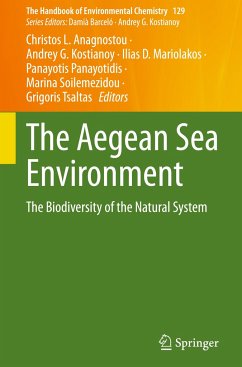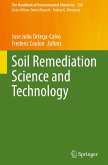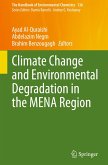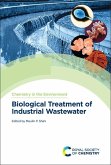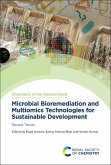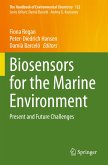The Aegean Sea Environment
The Biodiversity of the Natural System
Herausgegeben:Anagnostou, Christos L.; Kostianoy, Andrey G.; Mariolakos, Ilias D.; Panayotidis, Panayotis; Soilemezidou, Marina; Tsaltas, Grigoris
The Aegean Sea Environment
The Biodiversity of the Natural System
Herausgegeben:Anagnostou, Christos L.; Kostianoy, Andrey G.; Mariolakos, Ilias D.; Panayotidis, Panayotis; Soilemezidou, Marina; Tsaltas, Grigoris
- Gebundenes Buch
- Merkliste
- Auf die Merkliste
- Bewerten Bewerten
- Teilen
- Produkt teilen
- Produkterinnerung
- Produkterinnerung
This is the second of three Books that together provide an integrated picture of the Aegean Sea, presenting the natural components of the system (Book I and Book II) as well as the human presence in the extended area (Book III).
The Aegean Sea, also called Aegean Archipelagos, is an open, complex, and diverse marine system situated between the Black Sea and the Eastern Mediterranean, with different compartments and interactions. Book II offers a multidisciplinary perspective of the diverse habitats and intricate relationships that shape the Aegean Sea's coastal environment, covering the…mehr
Andere Kunden interessierten sich auch für
![Soil Remediation Science and Technology Soil Remediation Science and Technology]() Soil Remediation Science and Technology131,99 €
Soil Remediation Science and Technology131,99 €![Climate Change and Environmental Degradation in the MENA Region Climate Change and Environmental Degradation in the MENA Region]() Climate Change and Environmental Degradation in the MENA Region131,99 €
Climate Change and Environmental Degradation in the MENA Region131,99 €![Fragrances in the Environment Fragrances in the Environment]() Fragrances in the Environment105,99 €
Fragrances in the Environment105,99 €![Biological Treatment of Industrial Wastewater Biological Treatment of Industrial Wastewater]() Biological Treatment of Industrial Wastewater261,99 €
Biological Treatment of Industrial Wastewater261,99 €![Microbial Bioremediation and Multiomics Technologies for Sustainable Development Microbial Bioremediation and Multiomics Technologies for Sustainable Development]() Microbial Bioremediation and Multiomics Technologies for Sustainable Development263,99 €
Microbial Bioremediation and Multiomics Technologies for Sustainable Development263,99 €![Biosensors for the Marine Environment Biosensors for the Marine Environment]() Biosensors for the Marine Environment231,99 €
Biosensors for the Marine Environment231,99 €![Water Reuse and Unconventional Water Resources Water Reuse and Unconventional Water Resources]() Water Reuse and Unconventional Water Resources147,99 €
Water Reuse and Unconventional Water Resources147,99 €-
-
-
This is the second of three Books that together provide an integrated picture of the Aegean Sea, presenting the natural components of the system (Book I and Book II) as well as the human presence in the extended area (Book III).
The Aegean Sea, also called Aegean Archipelagos, is an open, complex, and diverse marine system situated between the Black Sea and the Eastern Mediterranean, with different compartments and interactions. Book II offers a multidisciplinary perspective of the diverse habitats and intricate relationships that shape the Aegean Sea's coastal environment, covering the Aegean Sea's biodiversity. Book II also, provides valuable insights into the current state and conservation of the cetaceans, Mediterranean monk seals, sea turtles, seabirds, and benthic communities that call the Aegean Sea home. The book closes with a chapter where experts in the field provide an overview of the functioning of the Aegean Sea natural system, highlighting existing knowledge gapsand proposing avenues for future research.
Given the breadth and depth of its coverage, this book serves as a valuable resource for researchers, scholars, and students interested in biology of the marine environment, as well as policymakers and conservationists seeking a comprehensive understanding of the Aegean Sea's complex natural systems.
The Aegean Sea, also called Aegean Archipelagos, is an open, complex, and diverse marine system situated between the Black Sea and the Eastern Mediterranean, with different compartments and interactions. Book II offers a multidisciplinary perspective of the diverse habitats and intricate relationships that shape the Aegean Sea's coastal environment, covering the Aegean Sea's biodiversity. Book II also, provides valuable insights into the current state and conservation of the cetaceans, Mediterranean monk seals, sea turtles, seabirds, and benthic communities that call the Aegean Sea home. The book closes with a chapter where experts in the field provide an overview of the functioning of the Aegean Sea natural system, highlighting existing knowledge gapsand proposing avenues for future research.
Given the breadth and depth of its coverage, this book serves as a valuable resource for researchers, scholars, and students interested in biology of the marine environment, as well as policymakers and conservationists seeking a comprehensive understanding of the Aegean Sea's complex natural systems.
Produktdetails
- Produktdetails
- The Handbook of Environmental Chemistry 129
- Verlag: Springer / Springer Nature Switzerland / Springer, Berlin
- Artikelnr. des Verlages: 978-3-031-59414-4
- 2024
- Seitenzahl: 428
- Erscheinungstermin: 4. Juli 2024
- Englisch
- Abmessung: 241mm x 160mm x 27mm
- Gewicht: 826g
- ISBN-13: 9783031594144
- ISBN-10: 3031594142
- Artikelnr.: 70262996
- Herstellerkennzeichnung Die Herstellerinformationen sind derzeit nicht verfügbar.
- The Handbook of Environmental Chemistry 129
- Verlag: Springer / Springer Nature Switzerland / Springer, Berlin
- Artikelnr. des Verlages: 978-3-031-59414-4
- 2024
- Seitenzahl: 428
- Erscheinungstermin: 4. Juli 2024
- Englisch
- Abmessung: 241mm x 160mm x 27mm
- Gewicht: 826g
- ISBN-13: 9783031594144
- ISBN-10: 3031594142
- Artikelnr.: 70262996
- Herstellerkennzeichnung Die Herstellerinformationen sind derzeit nicht verfügbar.
Christos L. Anagnostou, Research Director of the Institute of Oceanography at the Hellenic Center for Marine Research (HCMR). He studied Natural Sciences (biology and geology) at the Aristotle University of Thessaloniki - Greece and made his PhD (Dissertation) at the Ruhr University - Bochum, Germany. The last 40 years is active, carrying out research in geological oceanography at the Hellenic Center for Marine Research (HCMR). He was a visiting professor at the Aegean University and he is teaching also in postgraduate level the last 20 years at the School of Naval Architecture & Marine Engineering of the National and Technical University of Athens. Andrey G. Kostianoy - Doctor of physico-mathematical sciences, Chief Scientist at the P.P. Shirshov Institute of Oceanology of the Russian Academy of Sciences (Moscow, Russia), a Visiting Professor at the University of Liege (Belgium), Honorary Professor of Tver State University (Russia). He is a specialist in the field of physical oceanography, satellite remote sensing of the oceans and inland seas, regional climate change, environmental problems. He is Editor-in-Chief of 'The Handbook of Environmental Chemistry' book series in Springer. Ilias Mariolakos, Em. Prof. at the National & Kapodistrian University of Athens. Dr. rer. nat. of the Erlangen - Nuernberg University, Germany. Honorary Prof. of the University of Salzburg, Visiting Prof. at the Free University of Brussels, Visiting Teaching Fellow at the University of N.S.W. of Sidney-Australia. Director of the IFAQ - UNESCO seminars of quaternary deposits. Foreign member of the Russian Academy of the Natural Science. Appointed Chairman of the Board of Directors of IGME (Institute of Geological and Mineral Exploration) (Greek Geological Survey), Appointed delegate of Greece in many national committees. Elected chairman of the Greek Geological Society. During the last 30 years working on finding the connection between the geoenvironmental changes of the Aegean and Circum-Aegean areas and the Greek Mythology, during the last 100,000 years. Panayotis Panayotidis born in Thessaloniki (Greece) at 1953. BSc in Natural Sciences (1975) from the University of Thessaloniki (Greece), MSc in Oceanography and PhD in Marine Biology (1980) from the University of Aix-Marseilles (France). Research Director at the Hellenic Center for Marine Research (2000-2020). During the last 35 years he participated in several research projects in the research fields of seagrass and algae taxonomy, biology and ecology, benthic communities' structure and function, evaluation of eutrophication and water quality status, and rapid environmental assessment. He was coordinator of the habitat mapping project in the Greek marine Natura network (2000-2005), the monitoring project for the Ecological Quality Status evaluation in the Greek coastal and transitional water bodies (2006-2015) and the monitoringprogrammes of the Marine Strategy Framework Directive in the Greek seas (2016-2019). Marina Soilemezidou, PhD in Political Science & Environment, MSc in Oceanography and Marine Environment Management, is a Research Fellow at the Mediterranean Programme for International Environmental Law and Negotiation and works at the Academy of Athens. She has professional experience in the social, economic and environmental issues in Committee of Permanent Representatives I in the EU, in the areas of the civil protection in Greece and the exploitation of natural resources in the USSR. Grigoris Tsaltas is Professor Emeritus of International Law with the Faculty of International, European and Area Studies, at Panteion University of Athens. He is founder and Director of the European Centre for Environmental Research and Training (est. 2002), one of the most significant institutions promoting sustainability studies in Greece. He teaches Law of the Sea, International and European Environmental Law and Policy and Energy Policies for Sustainable Development in both in undergraduate and postgraduate levels. In the past, he has served as Minister of Environment and Climate Change, as well as Rector of Panteion University. He holds the J. Monnet Chair "European Union and Developing Countries".
Part I: LIFE IN THE LAND-AIR-SEA TRANSITION ZONES.- Chapter 1 Transitional Ecosystems Along the Aegean Sea Coastline of Greece.- Chapter 2 Coastal Habitats in the Aegean Sea: Soft Bottom, Seagrasses, and Hard Bottom.- Chapter 3 Seabirds of the Aegean.- Part II: LIFE IN THE SEA WATER MASSES.- Chapter 4 Microbial Life in the Aegean Sea.- Chapter 5 Phytoplankton Dynamics in the Aegean Sea.- Chapter 6 Mesozooplankton Dynamics in the Aegean Sea.- Chapter 7 The Fish Fauna in the Hellenic Seas with Emphasis to the Aegean Sea.- Chapter 8 Current State of Knowledge and Conservation Perspectives on the Cetaceans of the Aegean Sea.- Chapter 9 The Mediterranean Monk Seal (Monachus monachus) in the Aegean Sea. "The Living Myth of the Sirens".- Chapter 10 Sea turtles in the Aegean Sea.- Part III: BENTHIC FLORA AND FAUNA IN THE AEGEAN SEA.- Chapter 11 Seascape of Soft Bottom Benthic Communities in the Aegean Sea.- Chapter 12 Seaweed Flora and Vegetation of the Aegean Sea.- Chapter 13 Benthic Meiofauna in the Aegean Sea.- Chapter 14 Microbial Benthic Communities in the Aegean Sea.-Part IV: FUTURE RESEARCH FOR THE FUNCTIONING OF THE AEGEAN SEA SYSTEM.- Chapter 15 Biological Invasions in the Aegean Sea: Temporal Trends, Pathways, and Impacts.- Chapter 16 The Overview of the Actual Knowledge on the Functioning of the Aegean Sea Natural System and Perspectives for the Future Research.Part I: LIFE IN THE LAND-AIR-SEA TRANSITION ZONES.- Chapter 1 Transitional Ecosystems Along the Aegean Sea Coastline of Greece.- Chapter 2 Coastal Habitats in the Aegean Sea: Soft Bottom, Seagrasses, and Hard Bottom.- Chapter 3 Seabirds of the Aegean.- Part II: LIFE IN THE SEA WATER MASSES.- Chapter 4 Microbial Life in the Aegean Sea.- Chapter 5 Phytoplankton Dynamics in the Aegean Sea.- Chapter 6 Mesozooplankton Dynamics in the Aegean Sea.- Chapter 7 The Fish Fauna in the Hellenic Seas with Emphasis to the Aegean Sea.- Chapter 8 Current State of Knowledge and Conservation Perspectives on the Cetaceans of the Aegean Sea.- Chapter 9 The Mediterranean Monk Seal (Monachus monachus) in the Aegean Sea. "The Living Myth of the Sirens".- Chapter 10 Sea turtles in the Aegean Sea.- Part III: BENTHIC FLORA AND FAUNA IN THE AEGEAN SEA.- Chapter 11 Seascape of Soft Bottom Benthic Communities in the Aegean Sea.- Chapter 12 Seaweed Flora and Vegetation of the Aegean Sea.- Chapter 13 Benthic Meiofauna in the Aegean Sea.- Chapter 14 Microbial Benthic Communities in the Aegean Sea.-Part IV: FUTURE RESEARCH FOR THE FUNCTIONING OF THE AEGEAN SEA SYSTEM.- Chapter 15 Biological Invasions in the Aegean Sea: Temporal Trends, Pathways, and Impacts.- Chapter 16 The Overview of the Actual Knowledge on the Functioning of the Aegean Sea Natural System and Perspectives for the Future Research.
Part I: LIFE IN THE LAND-AIR-SEA TRANSITION ZONES.- Chapter 1 Transitional Ecosystems Along the Aegean Sea Coastline of Greece.- Chapter 2 Coastal Habitats in the Aegean Sea: Soft Bottom, Seagrasses, and Hard Bottom.- Chapter 3 Seabirds of the Aegean.- Part II: LIFE IN THE SEA WATER MASSES.- Chapter 4 Microbial Life in the Aegean Sea.- Chapter 5 Phytoplankton Dynamics in the Aegean Sea.- Chapter 6 Mesozooplankton Dynamics in the Aegean Sea.- Chapter 7 The Fish Fauna in the Hellenic Seas with Emphasis to the Aegean Sea.- Chapter 8 Current State of Knowledge and Conservation Perspectives on the Cetaceans of the Aegean Sea.- Chapter 9 The Mediterranean Monk Seal (Monachus monachus) in the Aegean Sea. "The Living Myth of the Sirens".- Chapter 10 Sea turtles in the Aegean Sea.- Part III: BENTHIC FLORA AND FAUNA IN THE AEGEAN SEA.- Chapter 11 Seascape of Soft Bottom Benthic Communities in the Aegean Sea.- Chapter 12 Seaweed Flora and Vegetation of the Aegean Sea.- Chapter 13 Benthic Meiofauna in the Aegean Sea.- Chapter 14 Microbial Benthic Communities in the Aegean Sea.-Part IV: FUTURE RESEARCH FOR THE FUNCTIONING OF THE AEGEAN SEA SYSTEM.- Chapter 15 Biological Invasions in the Aegean Sea: Temporal Trends, Pathways, and Impacts.- Chapter 16 The Overview of the Actual Knowledge on the Functioning of the Aegean Sea Natural System and Perspectives for the Future Research.Part I: LIFE IN THE LAND-AIR-SEA TRANSITION ZONES.- Chapter 1 Transitional Ecosystems Along the Aegean Sea Coastline of Greece.- Chapter 2 Coastal Habitats in the Aegean Sea: Soft Bottom, Seagrasses, and Hard Bottom.- Chapter 3 Seabirds of the Aegean.- Part II: LIFE IN THE SEA WATER MASSES.- Chapter 4 Microbial Life in the Aegean Sea.- Chapter 5 Phytoplankton Dynamics in the Aegean Sea.- Chapter 6 Mesozooplankton Dynamics in the Aegean Sea.- Chapter 7 The Fish Fauna in the Hellenic Seas with Emphasis to the Aegean Sea.- Chapter 8 Current State of Knowledge and Conservation Perspectives on the Cetaceans of the Aegean Sea.- Chapter 9 The Mediterranean Monk Seal (Monachus monachus) in the Aegean Sea. "The Living Myth of the Sirens".- Chapter 10 Sea turtles in the Aegean Sea.- Part III: BENTHIC FLORA AND FAUNA IN THE AEGEAN SEA.- Chapter 11 Seascape of Soft Bottom Benthic Communities in the Aegean Sea.- Chapter 12 Seaweed Flora and Vegetation of the Aegean Sea.- Chapter 13 Benthic Meiofauna in the Aegean Sea.- Chapter 14 Microbial Benthic Communities in the Aegean Sea.-Part IV: FUTURE RESEARCH FOR THE FUNCTIONING OF THE AEGEAN SEA SYSTEM.- Chapter 15 Biological Invasions in the Aegean Sea: Temporal Trends, Pathways, and Impacts.- Chapter 16 The Overview of the Actual Knowledge on the Functioning of the Aegean Sea Natural System and Perspectives for the Future Research.

